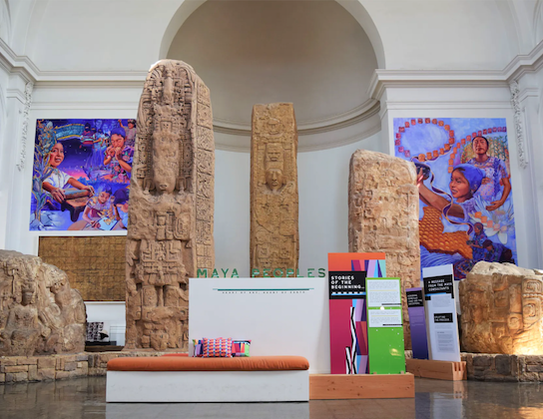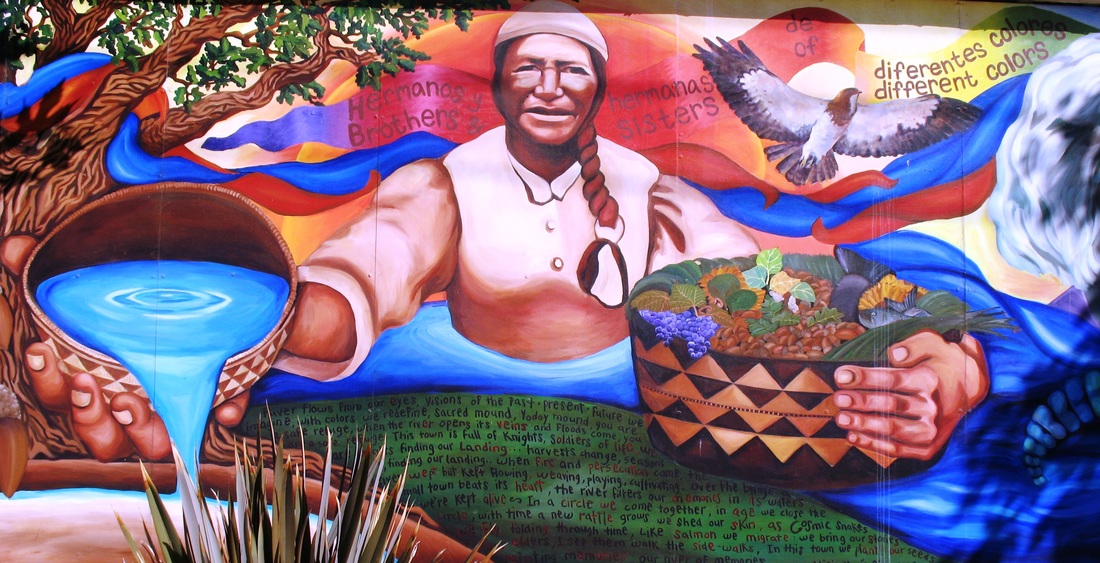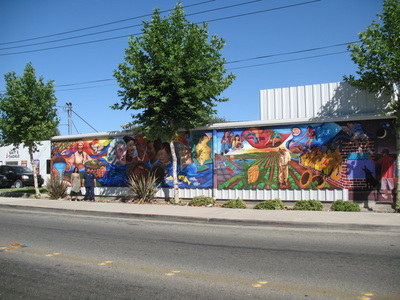Public Murals
Community Murals & Social Practice
Primer Guancasco (Encuentro) De Muralismo Colectivo y Comunitario de los Pueblos en Honduras
Desde el Corazon Lenca, Santa Barbara San Marcos, Honduras 2016

Mural: “Luz de Berta Cáceres, PRESENTE!” , Acrylic on wall, 19 feet by 10 feet, at the Plaza Civica, San Marcos, Santa Barbara, Honduras, Alicia Maria Siu Bernal, Primer Guancasco de Muralismo Colectivo y Comunitario de los Pueblos en Honduras, May, 2016.
In May 2016 I traveled to Honduras, my homeland, for the first gathering of muralists held in Honduras. We organized and named the gathering “Primer Guancasco de Muralismo Colectivo y Comunitario de los Pueblos en Honduras” to honor Berta Cáceres, one of our most cherished and ardent Lenca leaders; guardian of the rivers, and co-founder of The Civic Council of Popular and Indigenous Organizations of Honduras (COPINH) made up of 200 Lenca communities in western Honduras that organize to defend their ancestral lands and rivers from transnational corporations, namely hydro-electrical damns and mining operations. The muralist gathering was an effort to keep her memory and legacy alive through murals and as a manifestation of support for her case to obtain justice along with the hundreds of murdered environmental Indigenous activists whose murder cases have been left in impunity, including that of Tomás García of COPINH. Berta Cáceres was gunned down in her own home on March 2016 for opposing the construction of the Agua Zarca dam in Intibucá. As of now, an independent investigation has found the intellectual as well as the physical perpetrators of her murder, however, a year and a half after her murder, her case remains in impunity. The company that is behind her murder is DESA, their extractivist activities in Honduras are backed by govenrment militias, USAID and U.S. military aid to name a few. Many of the Indigenous local population fear for their future and the future of their children, access to land and desiccation of the lands. In a post military coup environment (military coup took place in 2009), in a country ruled by corruption, transnational corporations and high private interests, Berta’s spirit lives on and will have a lasting effect in the voice of the people!
In May 2016 I traveled to Honduras, my homeland, for the first gathering of muralists held in Honduras. We organized and named the gathering “Primer Guancasco de Muralismo Colectivo y Comunitario de los Pueblos en Honduras” to honor Berta Cáceres, one of our most cherished and ardent Lenca leaders; guardian of the rivers, and co-founder of The Civic Council of Popular and Indigenous Organizations of Honduras (COPINH) made up of 200 Lenca communities in western Honduras that organize to defend their ancestral lands and rivers from transnational corporations, namely hydro-electrical damns and mining operations. The muralist gathering was an effort to keep her memory and legacy alive through murals and as a manifestation of support for her case to obtain justice along with the hundreds of murdered environmental Indigenous activists whose murder cases have been left in impunity, including that of Tomás García of COPINH. Berta Cáceres was gunned down in her own home on March 2016 for opposing the construction of the Agua Zarca dam in Intibucá. As of now, an independent investigation has found the intellectual as well as the physical perpetrators of her murder, however, a year and a half after her murder, her case remains in impunity. The company that is behind her murder is DESA, their extractivist activities in Honduras are backed by govenrment militias, USAID and U.S. military aid to name a few. Many of the Indigenous local population fear for their future and the future of their children, access to land and desiccation of the lands. In a post military coup environment (military coup took place in 2009), in a country ruled by corruption, transnational corporations and high private interests, Berta’s spirit lives on and will have a lasting effect in the voice of the people!
50th Anniversary of Chicana/Chicano Studies
San Diego City College
https://sdcitytimes.com/campus-life/2022/05/18/dual-event-celebrating-50-years-of-chicana-o-studies-at-city-college-draws-crowd/
Museum of Us
https://museumofus.org/exhibits/maya-peoples-heart-of-sky-heart-of-earth
“The River and the People Have Stories to Tell” Patwin Homalands, (Knights Landing , California) 2006
"Somos Cucapa y Jamas Moriremos" El Mayor Cucapa, (Baja California, Mexico) 2007
Mural CucapaMural Cucapa, El Mayor Cucapa, Baja California, Mexico. 2006 Community Mural Project with Cucapa children of El Mayor.In 2007, the EZLN, Zapatistas of Chiapas organized an transnational encampment in Baja California for the Native community of Cucapa with the purpose of ensuring Cucapa's continuity. After witnessing the neglect, abuse, mistreatment and systematic isolation of First Nation peoples in the border-states, the Sixth Commission announced that something had to be done to stop the overall extermination of indigenous communities at the hands of the Mexican Government. Delegado Zero, then, along with the Cucapá Community of El Mayor, decided to invite adherents to the Sixth Declaration of the Lacandon Jungle to set up a peace camp during the fishing season to assure that the community would not be harassed by law enforcement agents during their fishing. This camp also served to preserve and revitalize traditions that were almost extinct within the Cucapá and others. The neighboring Kiliwa--with which the Cucapá traditionally intermarry--announced a "death pact" by refusing to bear children as their culture and people have been exploited and neglected to the brink of extinction. The "death pact" as well as documented harrasment through shootings by enforcement agents on Cucapa fishing boat parties, were the most urgent crisis wich prompted the need for this encampment. Consequently the camp served as a safe space in which humanitarian brigades, the Comandancia of the EZLN, at the time when Chiapas was experiencing a Red Alert, accompanied the Cucapá with the clear understanding that it is the community who sets the terms and conditions of decision making processes and other practices of self-determination. This experience opened up opportunities to re-activate the establishment of ways and means for self-sufficiency, autonomy and dignity.
|
As Delegado Zero put it when he called for the revitalization of forgotten indigenous communities in Northern Mexico: “We were already dead and we were called upon to become warriors, according to our legends. And as we were dead, we became what we are: shadows. And in a strict sense we are that: warriors of the shadows.”
As part of the Cucapa community’s three month campaign for fishing rights in the Colorado Delta of Baja California, the Cucapa children of El Mayor put together the ideas of this mural based on their interviews with elders, oral stories, natural environment, and their concerns as Natives of the Cucapa tribe. The mural depicts the Huishpa mountain, the Cucapa creation story of the emergence of the earth from the waters, the image of the moon with a Cucapa baby in traditional beadwork, fishing as a way of life, traditional Cucapa dancers, and natural elements such as the cachania plant used for building Cucapa traditional homes. |
"Birth of the Caracoles" San Cristobal De Las Casas, Chiapas, Mexico , 2003
Estacion Libre, Casa Naranja
Birth of the Caracoles, Oventic 2003
This mural was created in San Cristobal de las Casas, Chiapas, in the Estacion Libre stronghold in commemoration of the change of name of the Zapatista autonomous government units previously called "Juntas de Buen Gobierno" to “Caracoles”. Estacion Libre is an organization made up of people from underrepresented communities residing in Turtle Island. EL organizes encuentros, or exchanges, with the Zapatista communities and ourselves in order to bring together experiences and ideas for autonomous governance and holistic ways. The purpose of EL is to strengthen connections for ongoing solidarity efforts "between communities of color (in the U.S.) with each other and the Zapatista movement."




































